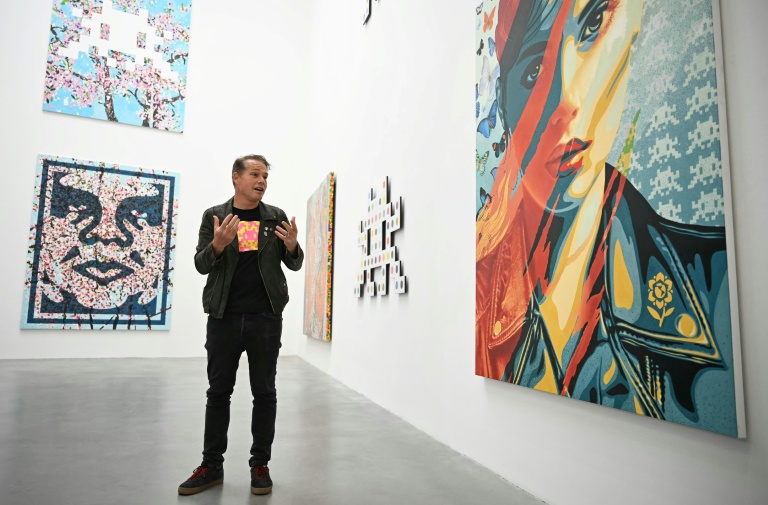Collaborative Art in Troubling Times: An Insight into “Triple Trouble”
In a world often overshadowed by conflict and despair, the exhibition “Triple Trouble” emerges like a beacon of hope. Renowned US activist Shepard Fairey, British sculptor Damien Hirst, and enigmatic French street artist Invader unite their distinct artistic visions, resulting in a vibrant showcase designed to inspire and uplift. The collaboration speaks volumes about the power of art in bridging divides, demonstrating that, even in the darkest times, there’s a space for joy and creativity.
A Journey of Collaboration
The conception of “Triple Trouble” took about 18 months, a labor of love born from mutual admiration among the three artists. “We all see ourselves as troublemakers because we have been,” Fairey reflected ahead of the exhibition’s opening in London. The project blends their individual styles with unique hybrid pieces, offering an accessible celebration of their artistic identities while emphasizing their shared values.
The Artists Behind the Exhibition
Shepard Fairey is perhaps best known for crafting the iconic “Hope” poster during Barack Obama’s 2008 presidential campaign. This piece, a visual landmark of ideology and change, showcased Fairey’s ability to distill complex emotions into compelling imagery. But his work extends beyond mere political statements; for instance, his poignant piece inspired by the 2015 Paris attacks captures a deeper cultural resonance, hanging in the office of French President Emmanuel Macron.
Damien Hirst’s presence in the exhibition brings a provocative edge, with his history steeped in exploring themes of death and mortality through controversial installations—think pickled sharks or bisected cows. His daring pieces command phenomenal prices in the contemporary art market, yet stir critical conversations about the nature of life and art.
On the other hand, Invader thrives in anonymity, concealing his identity behind a mask while leaving a legacy of pixelated mosaics inspired by the classic video game “Space Invaders.” His street art can be found adorning urban landscapes worldwide, infusing public spaces with playful yet thought-provoking insignia.
The Art of Joyful Collaboration
The collaboration between these artists defies the stereotype of the egotistical creator. Fairey highlighted the joyful nature of their joint process, stating, “This was a joyful process.” In an age marked by cultural division, the exhibition serves as a heartening reminder that even individuals considered difficult can unite through shared love for art.
Pieces within “Triple Trouble” are not merely juxtaposed works but rather reimagined collaborations that reflect the synergy of their distinct styles. Fairey describes a standout painting, “The Flames of Discontent,” which features a leather-clad woman walking into fire, accompanied by Hirst’s butterflies and Invader’s pixelated characters. This piece exemplifies how their individual influences can create new dialogues, lifting the collective spirit.
An Infiltrative Approach to Art
Fairey is deeply influenced by counterculture movements, drawing from punk rock, graffiti, and hip hop. His philosophy embraces what he terms the “inside-outside strategy,” believing that subverting established systems from within can lead to meaningful change. “If you can infiltrate the system and change it for the better within, that’s actually a really amazing bit of subversion,” he articulated.
Yet with artistic success comes critique. Fairey openly grapples with questions surrounding authenticity and commercialism in art. “What’s authentic, what’s too commercial?” he mused, acknowledging the inherent tensions faced by artists transitioning from obscurity to prominence. Despite the challenges, he maintains a firm commitment to his principles.
The Resilience of Hope
Reflecting on the broader context of hope, Fairey acknowledged a noticeable decline since the optimism surrounding Obama’s early years. However, he remains undeterred, citing that even nations with dark histories, like Germany, can rise to become progressive leaders in the arts and renewable energy. “I think there’s always hope to be had,” he asserted, capturing the essence of “Triple Trouble” as a testament to resilience and the enduring human spirit.
The exhibition at Newport Street Gallery stands as an inviting space, integrating the distinct styles of Fairey, Hirst, and Invader into a cohesive narrative of joy and collaboration. Their collective work demonstrates that while the world may wrestle with adversity, art holds the profound power to inspire, unite, and remind us of the potential for hope amidst chaos.



